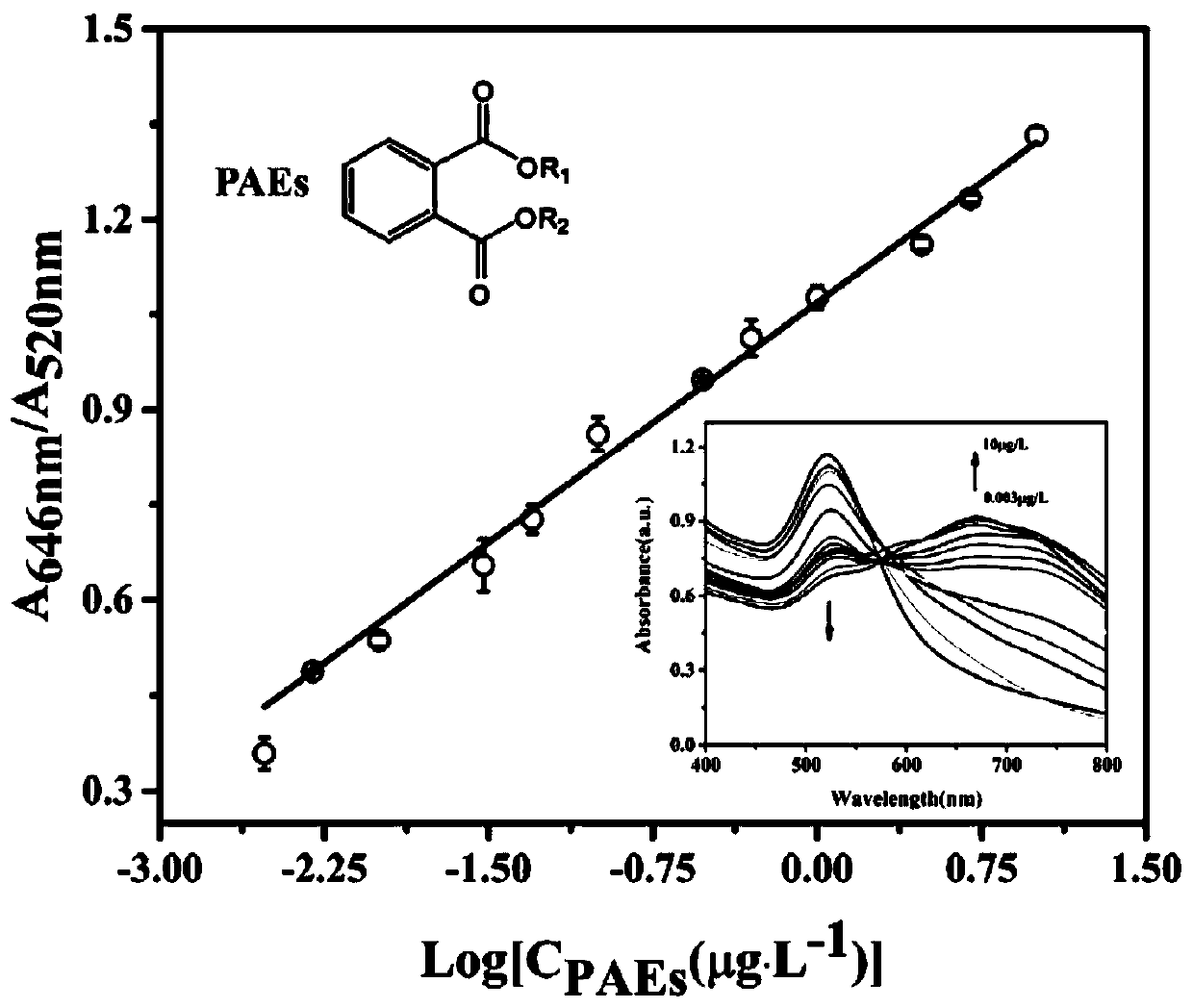Method and sensor for rapid visualization analysis of total amount of various phthalate pollutants
A technology of phthalic acid and pollutants, which is applied in the direction of analysis by chemical reaction of materials, material analysis by observing the impact on chemical indicators, color/spectral property measurement, etc. Detection, equipment are expensive, complex processing and other problems, to achieve the effect of more intuitive and visual detection results, easy operation and high sensitivity
- Summary
- Abstract
- Description
- Claims
- Application Information
AI Technical Summary
Problems solved by technology
Method used
Image
Examples
Embodiment 1
[0022] A colorimetric sensor based on a broad-spectrum nucleic acid aptamer to detect the total amount of various PAEs, using a broad-spectrum nucleic acid aptamer that can recognize a class of PAEs as a recognition element, and the absorbance is generated according to the change of the aggregation state of gold nanoparticles Ratio A 646nm / A 520nm The change of the PAEs concentration is quickly visualized and analyzed, and the sensor is constructed through the following steps:
[0023] (1) Use Mfold software to simulate the secondary structure of the long-chain nucleic acid aptamer sequence of PAEs, and use the Loop ring as the main body to cut and design its molecules by intercepting different branches on both sides to obtain nucleic acid aptamers of different lengths fragment. AutoDock molecular docking simulation experiments were performed on different aptamer fragments with DEHP, DBP, and BBP, and the truncated fragments that retained the binding sites of PAEs, had spec...
Embodiment 2
[0028] The experimental parameters affecting the sensitivity of the nucleic acid aptamer colorimetric sensor were optimized, including: the concentration of sodium chloride, the concentration of the nucleic acid aptamer and the incubation time of the system. The specific process is: respectively adding nucleic acid aptamer solution and sodium chloride solution with concentration ranges of 0.06-0.47 μmol / L and 17.24-103.45 mmol / L to the gold nano-sol system. The absorbance of different colorimetric systems was measured by a UV-visible spectrophotometer, according to A 646nm / A 520nm The optimal concentration of nucleic acid aptamer was determined to be 0.28μmol / L, and the optimal concentration of sodium chloride was 43.1mM. A after 4 minutes of reaction 646nm / A 520nm Tend to a steady state, the best time for system detection was determined to be 4min.
Embodiment 3
[0030] Weigh 1 g of DEHP, DBP and BBP in turn, and dissolve them in a 10 ml volumetric flask with ethanol as a solvent to obtain three PAEs stock solutions with a concentration of 0.1 g / mL. Then mix the three equal concentrations of PAEs solutions in equal volumes to obtain a standard mixture stock solution with a ratio of DEHP, DBP, and BBP of 1:1:1 and a total concentration of PAEs of 0.1 g / mL, which can then be diluted to obtain PAEs standards of different concentrations. Mix the pollutant solution. By mixing DEHP, DBP and BBP in different volumes, different proportions of PAEs mixed pollutant solutions can be obtained.
[0031] The concentration range of the PAEs mixed pollutants added to the nucleic acid aptamer colorimetric sensor constructed in Example 1 is 0.003 μg / L to 10 μg / L. After sufficient incubation, a UV-visible spectrophotometer is used to detect the change in the absorbance of the system and calculate A of gold nanoparticles 646nm / A 520nm value. figure 1...
PUM
 Login to View More
Login to View More Abstract
Description
Claims
Application Information
 Login to View More
Login to View More - R&D
- Intellectual Property
- Life Sciences
- Materials
- Tech Scout
- Unparalleled Data Quality
- Higher Quality Content
- 60% Fewer Hallucinations
Browse by: Latest US Patents, China's latest patents, Technical Efficacy Thesaurus, Application Domain, Technology Topic, Popular Technical Reports.
© 2025 PatSnap. All rights reserved.Legal|Privacy policy|Modern Slavery Act Transparency Statement|Sitemap|About US| Contact US: help@patsnap.com

